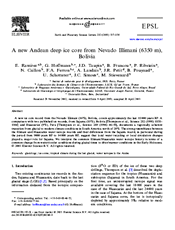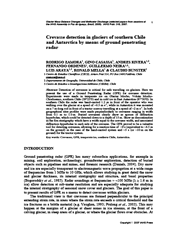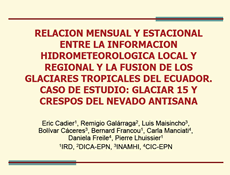En esta Sección los autores comparten los resultados de la investigación básica y aplicada realizada, que pueden ser de gran utilidad para el desarrollo y mayor conocimiento del tema.
A new Andean deep ice core from Nevado Illimani (6350 m), Bolivia
Autores: Ramirez E., Hoffmann G., Taupin D.J., Francou B., Ribstein P., Caillon N., Ferron F.A., Landais A., Petit J.R., Pouyaud B., Schotterer U., Simoes J.C. & M. Stievenard
Resumen:
 A new ice core record from the Nevado Illimani (16‡S), Bolivia, covers approximately the last 18 000 years BP. A comparison with two published ice records, from Sajama (18‡S), Bolivia [Thompson et al., Science 282 (1998) 1858^1864] and Huascara.n (9‡S), Peru [Thompson et al., Science 269 (1996) 46^50], documents a regionally coherent transition from glacial to modern climate conditions in South America north of 20‡S. The strong resemblance between the Illimani and Huascara.n water isotope records and their differences from the Sajama record, in particular during the period from 9000 years BP to 14 000 years BP, suggest that local water recycling or local circulation changes played a major role for Sajama. We interpret the common Illimani/Huascara.n water isotope history in terms of a common change from wetter/cooler conditions during glacial times to drier/warmer conditions in the Early Holocene. A new ice core record from the Nevado Illimani (16‡S), Bolivia, covers approximately the last 18 000 years BP. A comparison with two published ice records, from Sajama (18‡S), Bolivia [Thompson et al., Science 282 (1998) 1858^1864] and Huascara.n (9‡S), Peru [Thompson et al., Science 269 (1996) 46^50], documents a regionally coherent transition from glacial to modern climate conditions in South America north of 20‡S. The strong resemblance between the Illimani and Huascara.n water isotope records and their differences from the Sajama record, in particular during the period from 9000 years BP to 14 000 years BP, suggest that local water recycling or local circulation changes played a major role for Sajama. We interpret the common Illimani/Huascara.n water isotope history in terms of a common change from wetter/cooler conditions during glacial times to drier/warmer conditions in the Early Holocene.
Consecuencia del retroceso de los glaciares en el Perú
Autor: Zapata Luyo Marco
Resumen:
 El INRENA, a través de la Unidad de Glaciología y Recursos Hídricos, viene realizando trabajos de evaluación y monitoreo del comportamiento de glaciares y lagunas alto andinas con la finalidad de prevenir y mitigar los riesgos y desastres naturales, por efecto de avalanchas, aluviones y desbordes de lagunas de origen glaciar, así como, prevenir los futuros déficits del recurso hídrico, promoviendo su aprovechamiento de manera sostenible con fines múltiples en el ámbito geográfico de la Cordillera Blanca. Asimismo este tipo de estudios en los glaciares y zonas de alta montaña están íntimamente relacionados al aspecto del Cambio Climático Global. El INRENA, a través de la Unidad de Glaciología y Recursos Hídricos, viene realizando trabajos de evaluación y monitoreo del comportamiento de glaciares y lagunas alto andinas con la finalidad de prevenir y mitigar los riesgos y desastres naturales, por efecto de avalanchas, aluviones y desbordes de lagunas de origen glaciar, así como, prevenir los futuros déficits del recurso hídrico, promoviendo su aprovechamiento de manera sostenible con fines múltiples en el ámbito geográfico de la Cordillera Blanca. Asimismo este tipo de estudios en los glaciares y zonas de alta montaña están íntimamente relacionados al aspecto del Cambio Climático Global.
Crevasse detection in glaciers of southern Chile and Antarctica by means of ground penetrating radar
Autores: Zamora Rodrigo, Casassa Gino, Rivera Andrés, Ordenes Fernando, Neira Guillermo, Araya Luis, Mella Ronald & Claudio Bunster
Resumen:
 Detection of crevasses is critical for safe travelling on glaciers. Here we present the use of a Ground Penetrating Radar (GPR) for crevasse detection. Experiments were made in temperate ice on Glaciar Mocho, Volcán Mocho- Choshuenco, southern Chile (39°25′S) and in cold ice in East Antarctica (87°30′S). In southern Chile the radar was hand-carried 1.2 m in front of the operator who was walking over the glacier at a speed of ~0.5 m s-1, while in Antarctica it was mounted on a 7 m-long rod in front of a tractor convoy travelling at a speed of ~2 m s-1. In both geographical sites profiles were made perpendicularly to crevasses ranging in width from 0.1 m to 1.0 m. Buried crevasses clearly show as apexes of diffraction hyperbolae, which could be detected down to a depth of 15 m. Show as discontinuities in the firn stratigraphy which have a width equal to the crevasse width, and associated diffraction hyperbolae to each side of the crevasse. The GPR proved to be a valuable tool for detecting crevasses, allowing for a reaction time of ~9 s (equivalent to ~4.5 m on the ground) in the case of the hand-carried system and ~5 s (or ~10 m on the ground) for the tractor system. Detection of crevasses is critical for safe travelling on glaciers. Here we present the use of a Ground Penetrating Radar (GPR) for crevasse detection. Experiments were made in temperate ice on Glaciar Mocho, Volcán Mocho- Choshuenco, southern Chile (39°25′S) and in cold ice in East Antarctica (87°30′S). In southern Chile the radar was hand-carried 1.2 m in front of the operator who was walking over the glacier at a speed of ~0.5 m s-1, while in Antarctica it was mounted on a 7 m-long rod in front of a tractor convoy travelling at a speed of ~2 m s-1. In both geographical sites profiles were made perpendicularly to crevasses ranging in width from 0.1 m to 1.0 m. Buried crevasses clearly show as apexes of diffraction hyperbolae, which could be detected down to a depth of 15 m. Show as discontinuities in the firn stratigraphy which have a width equal to the crevasse width, and associated diffraction hyperbolae to each side of the crevasse. The GPR proved to be a valuable tool for detecting crevasses, allowing for a reaction time of ~9 s (equivalent to ~4.5 m on the ground) in the case of the hand-carried system and ~5 s (or ~10 m on the ground) for the tractor system.

|
Escenarios de reducción de caudales en la cuenca Humboldt del Antisana
Autores: Cadier Eric, Villacís Marcos, Loyo Christian, Cuenca Erick, Garcés Antinea, Lhuissier Pierre, Maishincho Luis, Paredes Diego, Caceres Bolivar & Bernard Francou
 La información contenida en esta presentación realizada en el evento sobre “Cambio Climático y Retroceso de Glaciares en América Latina: Consecuencias para los Recursos Hídricos”, organizado por Inwent y el Ministerio Federal de Cooperación y Desarrollo de Alemania en Quito/06, está referida al cálculo de caudales provenientes del volcán andino Antisana en el Ecuador, la extrapolación de la situación para la propuesta de escenarios, y una comparación de la cuenca de Humboldt no regularizada con el caudal regularizado por el caudal del volcán nevado. La información contenida en esta presentación realizada en el evento sobre “Cambio Climático y Retroceso de Glaciares en América Latina: Consecuencias para los Recursos Hídricos”, organizado por Inwent y el Ministerio Federal de Cooperación y Desarrollo de Alemania en Quito/06, está referida al cálculo de caudales provenientes del volcán andino Antisana en el Ecuador, la extrapolación de la situación para la propuesta de escenarios, y una comparación de la cuenca de Humboldt no regularizada con el caudal regularizado por el caudal del volcán nevado.
Ice elevation, areal and frontal changes of glaciers from National Park Torres del Paine, Southern Patagonia icefield
Autores: Rivera Andrés & Gino Casassa
Resumen:
 Ice elevation changes since 1975 and ice areal changes since 1945 of glaciers in the southeastern part of the Southern Patagonia Icefield (SPI) are presented. Comparison of digital elevation models, GPS, and optical survey data revealed high thinning rates for all the ablation areas of the glaciers, with average values between 1.4 and 3.4 m a_1 and maximum ice thinning of 7.6 m a_1. Ice elevation changes for the glacier accumulation areas were Ice elevation changes since 1975 and ice areal changes since 1945 of glaciers in the southeastern part of the Southern Patagonia Icefield (SPI) are presented. Comparison of digital elevation models, GPS, and optical survey data revealed high thinning rates for all the ablation areas of the glaciers, with average values between 1.4 and 3.4 m a_1 and maximum ice thinning of 7.6 m a_1. Ice elevation changes for the glacier accumulation areas were
smaller than the estimated errors, and no significant trends could be detected. All the glaciers are retreating and shrinking considerably, with a total areal loss of 62.2 km2, which represents 8% of the total ice area of 1945. This trend is in agreement with other similar measurements carried out during recent decades for several glaciers of the SPI. The high thinning rates for the ablation areas of the SPI have been primarily interpreted as a result of the increase in temperature observed in the region, however, this warming trend is not large enough to account for all the ice thinning, indicating that dynamic factors could be important, especially in glaciers which have been thinning dramatically, allowing frontal calving fronts to reach nearly floating conditions. More measurements are needed to test and
validate dynamic hypotheses related to glacier behavior in Patagonia.

|
Misión al Coropuna (2204): Estimación del espesor de hielo y pérdida del volumen
Autores: Herold C., Peduzzi P. & W. Silverio
Resumen:
 Se presenta la información recogida en el glaciar de Coropuna, para aplicar un modelo que busca medir el espesor del campo de hielo; el modelo compara periodos y permite extrapolar los resultados a todo el glaciar. Los resultados demuestran la pérdida de masa de hielo. Se presenta la información recogida en el glaciar de Coropuna, para aplicar un modelo que busca medir el espesor del campo de hielo; el modelo compara periodos y permite extrapolar los resultados a todo el glaciar. Los resultados demuestran la pérdida de masa de hielo.
Recent glacier variations at the Aconcagua basin, central Chilean Andes
Autores: Bown Francisca, Rivera Andrés & César Acuña
Resumen:
 La investigación muestra que los glaciares de la cuenca del Aconcagua, en los Andes centrales de Chile, son sensibles al cambio climático. Algunos tienen grandes variaciones evidenciadas a partir de fotos aerofotogramétricas, pero hay otros cuyas variaciones responden más a condiciones locales específicas. En todos los casos, la reducción en el caudal acuífero se explica por la reducción de nieve en los glaciares. La investigación muestra que los glaciares de la cuenca del Aconcagua, en los Andes centrales de Chile, son sensibles al cambio climático. Algunos tienen grandes variaciones evidenciadas a partir de fotos aerofotogramétricas, pero hay otros cuyas variaciones responden más a condiciones locales específicas. En todos los casos, la reducción en el caudal acuífero se explica por la reducción de nieve en los glaciares.
Relación mensual y estacional entre la información hidrometeorológica
Autores: Cadier Eric, Galárraga Remigio, Maisincho Luis, Cáceres Bolívar, Francou Bernard, Manciati Carla, Freile Daniela & Pierre Lhuissier
Resumen:
 Esta presentación realizada en Quito/06 presenta información sobre resultados de modelos utilizados para la generación de balance para la zona de ablación en Nevado, Ecuador para diferentes periodos, considerando variables pluviométricas y meteorológicas globales. Esta presentación realizada en Quito/06 presenta información sobre resultados de modelos utilizados para la generación de balance para la zona de ablación en Nevado, Ecuador para diferentes periodos, considerando variables pluviométricas y meteorológicas globales.
The carbonisation and decarbonisation of the atmosphere: Systematically linking sustainable development, decarbonisation, and adaptation programs using qualitative comparative means
Autor: Lucio Muñoz
Resumen:
 It can be said that the original impacts of human beings on the environment were barely noticeable when they lived as nomadic societies. As they evolved from nomadic to sedentary societies; from subsistence societies to modern industrial and mixed economies, their impacts on the environment grew each time more and more. There seems to be now a general agreement that economic development without social and environmental concerns led to the carbonisation of the atmosphere and to calls to change course in the name of the environment and for the sake of current and future generations. Then the idea of sustainable development came along formally in the late 1980s to minimize current green house emissions as well as later programs such as the United Nations Framework Convention on Climate Change and the Kyoto Protocol and associated mitigation and adaptation programs, which are aimed at decarbonising the atmosphere in a sustainable manner. It can be said that the original impacts of human beings on the environment were barely noticeable when they lived as nomadic societies. As they evolved from nomadic to sedentary societies; from subsistence societies to modern industrial and mixed economies, their impacts on the environment grew each time more and more. There seems to be now a general agreement that economic development without social and environmental concerns led to the carbonisation of the atmosphere and to calls to change course in the name of the environment and for the sake of current and future generations. Then the idea of sustainable development came along formally in the late 1980s to minimize current green house emissions as well as later programs such as the United Nations Framework Convention on Climate Change and the Kyoto Protocol and associated mitigation and adaptation programs, which are aimed at decarbonising the atmosphere in a sustainable manner.
|